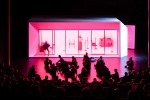A portion of the audience will take the stage at the Freud Playhouse this weekend, partying behind glass panels.
The panels are part of a structure meant to resemble journalist and novelist Joan Didion’s 1960s home. The architectural work serves as the set for “The White Album,” a multimedia performance of Didion’s essay of the same title. Created by director Lars Jan in collaboration with Early Morning Opera, the performance accommodates both a regularly seated “outer audience” and an “inner audience” of about 25 members. The show, which premiered in October at the Brooklyn Academy of Music, will come to Westwood in association with the Center for the Art of Performance at UCLA from Friday to Sunday.
The essay, published in a collection in 1979, covers aspects of Didion’s personal life as well as political movements that occurred during her time as a journalist. While the essay is read aloud to the outer audience, the inner audience plays a different role in interpreting “The White Album.” Listening to in-ear monitors, inner audience members are fed directions throughout the show and choose from different paths of action offered to them related to the topics in the essay. Jan said the varying audience perspectives help the performers explore themes of action and inaction from the 1960s to the present.
“In the essay itself, … there’s the idea of the individual who is a journalist, who’s watching things unfold but who is not particularly inclined to participate, versus the messy, challenging job of creating a group and figuring out what that group wants to do,” Jan said. “I’m trying to embody both of those things in the same performance on stage.”
The inner audience is set apart and prepared for its role well before the actual performance, said choreographer Stephanie Zaletel. Before they take the stage, the volunteer group will share a meal with the creative team and converse about the essay’s historical background. As a journalist, Didion explored the Black Panther Party and the 1968 San Francisco State University strike, among other movements. The information helps inner audience members better understand the context of the essay, Zaletel said.
[RELATED: Student worker union holds protest over frustration with UCPath system]
Inner audience members will spend the duration of the show on stage, celebrating at one of Didion’s many house parties as the show opens and eventually leaving the house as the performance progresses. They will be asked to answer questions and engage in conversations related to the movements and ideas within the essay. Other than a few stage directions involving choreographed dances and groupwide conversations, Zaletel said the on-stage audience members have the freedom to make choices as they please.
“There’s boundaries and structure, but there aren’t rules,” Zaletel said. “You can take the in-ear monitors out, you can talk to people, you can leave. It teaches you a lot about the choices you make in a really beautiful way.”
Because many of the people covered in Didion’s essay were in their 20s at the time, Jan said the volunteer group is made up of students, activists and artists under 30. In contrast, the outer audience has a wider age range. Mia Barron, the performer tasked with reciting the essay, said the difference in age between the two groups is a metaphor for those who helped bring about change in the past and those pushing for new ideas in the current age of rising social movements like #MeToo and Black Lives Matter.
“The seated audience is usually collectively older than the audience on the stage,” Barron said. “(The goal is) for those two groups to encounter each other … and look at each other and to think about who has the hope for change, the appetite for change, the energy for change, and where despair lies within that and where it’s warranted.”
[RELATED: Art show seeks to highlight diverse roles in the environmental justice movement]
Near the end of the staged performance, the inner audience will join the seated members for an open-forum conversation. The distinction between their roles provides a different experience for each group, which represents a concept Jan noted in the essay about Didion’s observational role, Zaletel said.
As a journalist, Didion did not participate in the movements and covered them in a way that does not capture their many dimensions, at least not when viewed through a present-day lens, Jan said. The outer audience parallels Didion’s experience of viewing events from afar, while the inner audience serves to represent the activists who lived through these movements in a more hands-on way, Jan said.
Having participated as an inner audience member for a performance of the show at the Brooklyn Academy of Music in November, Zaletel said the group should not feel like performers in the show. Instead they should aim to engage in the experience, choosing between options or electing not to choose. The message of “The White Album,” she said, was best demonstrated by two different audiences and their distinct perspectives, as opposed to a more conventional performative format.
“You get a really interesting sense of then and now, and there’s a lot of metaphor in action versus inaction, about sitting and watching versus being inside the house,” Zaletel said.
